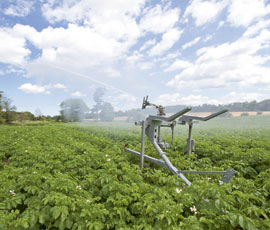Cost of potato irrigation has doubled since 2005

The rising cost of irrigation and a new see treatment were two key topics discussed at the East of England Potato Day in Suffolk last week. Louise Impey reports
The cost of applying water to potato crops is rising fast and has doubled since 2005, according to Jerry Knox of Cranfield University.
“It now costs £100 to apply 25mm to 1ha, compared with just £50 for the same amount six years ago,” he said.
As water availability will only become less reliable and more expensive in the future, every effort should be made to irrigate efficiently, he advised.
“That doesn’t necessarily mean using less water. Better use and less waste are the key points, so growers should concentrate on putting the right amount of water on at the right time and in the right place.
“Remember that you are irrigating the soil, not the plants. And water behaves differently in different soils.”
That means using different application rates for changing soil types, he said. “The best thing is to go and dig out a ridge and see where the water has got to. That will give you an idea about the uniformity of irrigation.”
Getting the most from any irrigation network, regardless of the system used, means optimising both the performance of the equipment and soil and water management practices, added Mr Knox.
“The most common problem is low pressure. If the pressure is down, the result is a lower flow rate, which means that the application rate drops and the uniformity is reduced.”
Mr Knox suggested that growers carry a pressure gauge in their trucks to check operating pressure. “The pressure at the gun should be around 4.5 bar, but check with the manufacturer’s guidelines. And remember that if the pressure is wrong, any wind while you are irrigating will make matters worse.”
Extending or overstretching irrigation systems is often the reason for low pressure, he said. “You must consider the impacts of increased demand on the whole network.”
Care is also required when you switch technology, he stressed. “Guns have higher application rates and larger droplets. So think about any effects they may have on soil damage.”
Demonstrating best practice, which is becoming important for both the regulator and customers, can be done with a water audit, he added. “It combines measurement with evaluation, to account for all the water entering and leaving the system.”
Not only does an audit let you look at current practice, it helps to identify scope for improvement, he stressed.
The Rising Cost of Watering | |
To apply 25mm on 1ha | |
Water | £10 |
Labour | £5 |
Energy | £85* |
Total | £100 |
*Assuming a rain gun, hosereel and diesel pump | |
Source: Cranfield University | |
Defoliation Trials
Timing has proved to be more important than the programme used in mature crop defoliation trials this year, reported Reuben Morris of Frontier Agriculture.
A comparison of flailing, desiccant sequences and combinations of flailing and spraying gave no differences, he said.
“Crops have come to harvest earlier than normal,” he pointed out. “So the difficulty has been getting the timing right, so that the size fraction isn’t exceeded, rather than choosing the right crop sequence.”
In all treatments, crops were easy to kill, he concluded. “Providing you went earlier, the results have been very good.”

